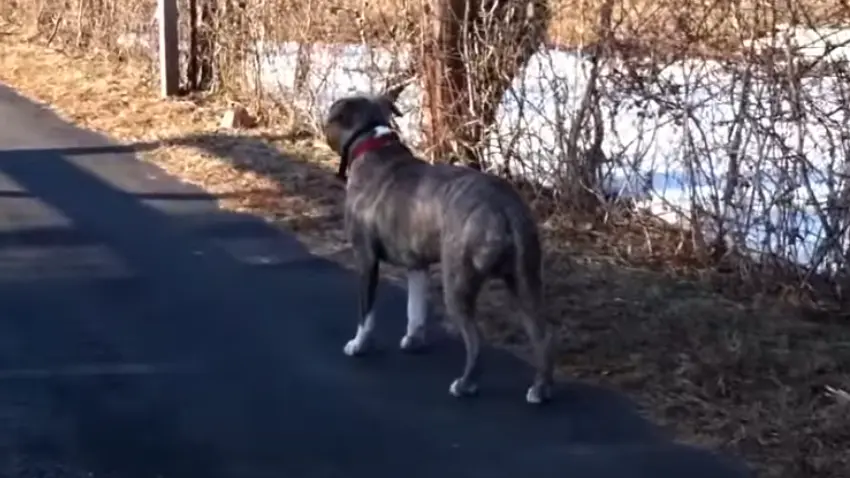Do Wireless Dog Fences Really Work? Here’s the Truth!
Do wireless dog fences really work? There are divided arguments about this, but many pet owners swear by this fence when it comes to preventing escapes and vehicular accidents.
But since there’s no physical fence, you should understand that there’s a limitation to what an invisible fence can do. In this post, I will discuss how wireless dog fences work and if it’s suitable for you. I’ll also dive deep into the limitations of the system, so you’ll know how to use it efficiently.

Can A Dog Run Through An Invisible Fence?

This depends on your dog’s pain tolerance. Some dogs like Pit Bulls and Rottweilers have a higher chance of running through an invisible fence.
They can endure the static correction until the collar runs out of battery.
In this case, you have the option to increase the static correction or train your dog even more. The latter is often the most preferred method because it’s more humane and will prevent negative behavior formation.
Whether it’s an underground or wireless invisible fence, it always boils down to your dog’s personality. This is why training is an integral part of implementing an invisible fence on your property.
Aside from that, you should be modest in playing with the level of static correction you’re going to set. While the highest setting may guarantee that your dog won’t run away, it may cause a slew of problems in the long run.
How deep is an invisible fence buried?
For the underground fence, the wires have to be buried at least three inches from the surface. This depth allows reliable signal transmission without being dug up easily.
However, some systems may require a shallower depth of 1 to 2 inches. It’s important to check the installation instruction to ensure that the wires and collar receive consistent signals.
Take note that the goal of burying the wires is to protect them against lawnmowers, lawn activity, and stray animals. This means you have to dig shallow trenches all over the perimeter of your yard.
For our invisible fence, we used a trencher to dig without the back-breaking process. You simply push it through the part where you want to bury the wires, and it will do the job for you.
However, if the fence will pass through the pavement, you need a grinder to slice through the concrete.
Do Wireless Dog Fences Really Work in the snow?
Using an invisible fence during winter can be tricky. If your yard is slumped with inches of snow, the signal transmission will be affected.
Meanwhile, some units have better sensitivity and can endure a few inches of snow.
I suggest checking it for yourself. Turn the system on while holding the receiver collar. If the warning beep and static correction kick in, it’s safe to say that your invisible fence is working just fine.
But to be sure, it’s best to rake the snow to avoid glitches. Also, make sure that the batteries of the collar are well-charged.
It’s important to check the signal field of the invisible fence you’re using. This is the height to which the signal from the buried wires can reach.
If the signal field is 3 feet from the ground, the fence will not work if the post is covered with 2 to 3 feet of snow. If we’re going to factor in your dog’s height, the collar will be much outside the signal field.
You’re lucky if the fence system you have is equipped with an adjustable signal field. This will give you an allowance to get the transmission past the thick snow.
Is the invisible fence worth the money?
If you want added protection for your dog, an invisible fence is an excellent choice. It will prevent escapes, especially for dogs that can jump off a physical fence easily.
Also, an invisible fence is far cheaper than putting up an actual fence. It’s very easy to install, and the system will be at work in less than a day.
If you’re looking for brands you can trust, the following are some that I recommend:
-
PetSafe
PetSafe is the leader in containment solutions for pets. Whether it’s wireless or underground invisible fences, this brand is the top choice among pet owners.
Their containment systems are affordable and a breeze to set up.
-
Extreme Dog Fence
Like PetSafe, this brand offers a wide range of wireless and buried fence systems. You can also choose the range of the fence to suit the size of your yard.
They also offer excellent warranties for every invisible dog fence they sell.
-
SportDOG
As a dog owner, I trust this brand because of its affordable price and reliable performance.
Like PetSafe and Extreme Dog Fence, SportDOG comes in a complete set of fence components.
How long does an invisible fence last?

An invisible dog fence can last for decades if installed and maintained well. On average, an underground dog fence can last for 20+ years if it won’t be disturbed harshly.
The longevity of these systems also depends on the weather in your area, activity in your yard, and the location of the installation.As for wireless invisible fences, the lifespan is almost the same as with the underground type. To increase the wireless system’s lifespan, you should install the transmitter in a spot safe away from outdoor elements.
How can I keep my dog in the yard?

There are many ways to keep your dog within your yard. First, a physical fence is a common option since it creates a solid barrier between your yard and the outside world.
However, you have to mind the height, so your dog won’t jump off it quite easily.
Another option is to leash your dog on a dog run. However, this requires close supervision to prevent the leash from wrapping all over your dog’s body.
If you’re going to work and are worried that your dog might escape your yard, a wireless fence is the best choice.
This creates a circular barrier using radio signals. Once your dog tries to breach the perimeter you set, its receiver collar will set off and produce a static charge.
At what age can a dog use an invisible fence?
Dogs can be introduced to invisible fences as early as 8 to 10 weeks. However, you shouldn’t use the static correction just yet. Start training your dog to recognize the sound warning once it approaches the invisible barrier.
Once your dog is much older, you can start using the static correction with the lowest setting.
Remember that using a very strong correction on a small pup can cause harm. Always be gentle and wait until your dog is big enough to handle consistent training.
Are shock collars for dogs cruel?
A shock collar is battery-powered, so it’s unlikely to cause serious injuries like what an electric dog fence does. However, it’s important to set it right to prevent problems.
A very strong shock correction can injure a dog and eventually lead to behavioral problems.
Remember that the goal of using shock collars is to serve as a warning and not a punishment. As long as you use them right, using shock collars will not be cruel to your pet.
How much is an invisible fence per foot?
The pricing for invisible fences varies across companies. On average, professionally installed invisible fences will cost around $2.50 per foot. If you decide to install it on your own, you can save as much as $1 per foot.
However, this means doing all the hard work, especially if the system doesn’t work as expected.
How do you train a dog to be scared of an underground fence?
Remember that the goal of an invisible fence is for your dog to react to the warning beep. This way, the pooch will be spared from the static correction. Here’s a quick look at how to do it:
- To do this, you need to set up the flag markers and walk your dog along the boundary wire.
- Turn the warning beep on and see how your dog will react whenever it sets off.
- If your dog runs back to safety, give it a treat. If it continues to approach the limits, call its name right away.
- You have to repeat this process many times until your dog recognizes the beep and associates it with running back.
For how long should I train my dog for an invisible fence?
This just depends on how quick a learner your dog is. On average, it may take about 14 days but if your dog learns slowly it may take more than two weeks.
However, you should not try to do it quickly and be patient during the training.
How do I run an invisible fence under my driveway?
Running an invisible fence under your driveway takes more work than simply burying it on yard soil. Here’s what you need to do:
- Most driveways are paved, so the first thing to do is mark where you plan to run the wires. You can use chalk for this.
- Next, cut through the pavement using a concrete grinder or masonry blade. You only need to slice a narrow channel enough to fit the wires.
- After that, bury the wires around 1 to 3 inches deep, depending on what the installation guide indicates.
- Once the wires are all placed, fill the opening with an asphalt sealer caulking. You’d have to let this cure for a few hours before driving on it.
- If you have a gravel driveway, you will do the same, but you should rake the gravel back in place after installation.
Where do flags go on the invisible fence?
The flags of your invisible fence must be placed just inside the boundary you set. It should be staked right where the beep gets triggered. This will let you train the dog without the risk of setting off the static correction.
Never place the flags right where the perimeter ends. This will deprive your dog of any buffer to run back before the static charge sets off.
What type of wire to use for underground dog fences?
An underground electric fence usually uses a 14 or 16-gauge solid wire. It’s made of copper for the best conductivity and durability. It’s around 45 mm thick, though other brands will have thicker or thinner wires.
Usually, the wider the range is, the thicker the wires should be. This guarantees that the wire can put up with the strong current that will pass through it. It will also prevent breakage along the fence, which can be a pain to detect and fix.
Remember that you can’t use just about any wire for underground fences.
Aside from the metal itself, you also have to consider the insulation. It should be rated for underground use. For most underground fences in the market, plastic and polyethylene are the most common options.
Can you install an invisible fence above the ground?
Theoretically, you can lay the wires in the open, and it will function just the same. However, it’s a tripping hazard, and there’s a high chance that your dog will chew it. When that happens, the pooch can now run freely without any static correction.
The only exception here is if you’re going to attach the invisible fence right to your physical fence. You can also run the wires on your previous wired dog fence posts.
This is an excellent option if you don’t want to do any digging. But since it’s exposed in the open, the wires will sustain more wear and tear than when it’s buried.
Conclusion
Do wireless dog fences really work? Yes! These systems are convenient options for those who can’t afford to put up a physical fence. If paired with proper training, a wireless dog fence will serve you well.
Just remember that a wireless pet fence requires proper maintenance as with other containment systems. Most of all, it should be used for training and not as a form of punishment.
